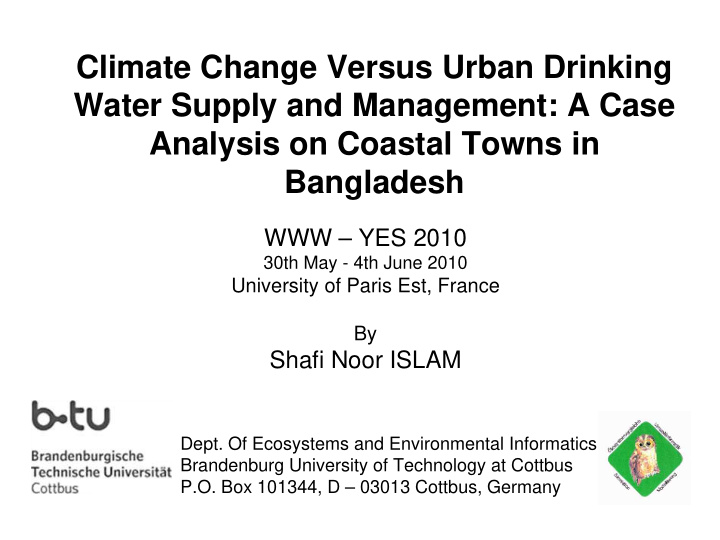



Climate Change Versus Urban Drinking Water Supply and Management: A Case Analysis on Coastal Towns in Bangladesh WWW – YES 2010 30th May - 4th June 2010 University of Paris Est, France By Shafi Noor ISLAM Dept. Of Ecosystems and Environmental Informatics Brandenburg University of Technology at Cottbus P.O. Box 101344, D – 03013 Cottbus, Germany
Contents of Research 1. Introduction 2. Research Objective/ Data Methodology 3. Research Ideas 4. Results 5. Conclusion
1.Introduction Bangladesh is located in the Ganges-Brahmaputra-Meghna Rivers catchments
Physiography of Bangladesh The area is 144,570 km², The coastal area is 36,500 km² Where 35 million people are living and fighting against food Insequrity and quality drinking water.
Arsenic in Groundwater in Bangladesh A limited number of southern coastal towns are contraminated by Arsenic In ground water and 82% drinking water is collecting from ground water.
2. Research Objectives/ Data and Method • The aim of this research is to develop a comprehensive integrated framework for strategic environmental planning that can meet needs of the present and future coastal communities in the Ganges Delta in Bangladesh • The objectives of this research are the following: - Ensure food security - Quality drinking water availability - Protection of urban ecology of coastal towns • Which could be useful to decision makers in Bangladesh, the international community, aid delivery organizations, local initiative groups and the local community of the coastal towns in Bangladesh.
Data and Methodology • Primary data on Water salinity were collected from 17 coastal towns in the southern part of Bangladesh and tested at the SRDI laboratory. • PRA practices were arranged with the inhabitants of coastal towns and stakeholders to measure the drinking water quality, and information on climate change impacts on drinking water in the coast. • All collected data and information has been analysed, visualized through ArcGIS 9.2 and other soft ware such as; SPSS, EXCEL, EVIEW and VENSIM.
3. Research Ideas Natural and Climate Change Anthropogenic factors Sea Level Rise Temperature Change High/ Cold Temperature Floods/ Tidal (Dry/Compactment Soil) Salinity Erosion Inundation Increase Public Expenditure on Flood and Salinity Intrusion in the Mitigation Measures Coastal Urban Areas Damage of Coastal High Salinity in Urban Ecology Surface and Ground Water Quality Damage of Urban Health Risk Urban Drinking Water
Location of Coastal Towns There are 101 coastal towns are located in the coastal region in Bangladesh, Where only 18% surface water is using as drinking water to the urban people
Drinking Water Crisis in the Coastal Towns The three major rivers are carrying100,000 to 140,000 m³/s upstream water and 1.8 to 2.4 billion tones of sediments loads are deposited on the bed and Bay of Bengal
4. Results Salinity intrusion in surface and ground water In the coastal towns of the Ganges delta
High Water Salinity in Coastal Towns 60 Barguna Mathbaria Pathorghata 50 Kalapara Water Salinity (EC dS/m) Galachipa Munchiganj Kaliganj 40 Ashasuni Sathkhira Koyra Paikgacha 30 Botiaghata Dumuria Rupsha 20 Morelganj Mongla Bagerhat 10 Threshold Line 0 Jan Feb Mar Apr May Jun Jul Aug Sept Oct Nov Dec Time (Months) 2 dS/m is the theshold value for potable drinking water in Bangladesh
Climate Change Impacts on Coastal Towns Due to Climate change impacts with 1.5 m SLR about 17 million (15%) of people will be affected. It has been estimated that 22,000 km² (16%) coastal land will go under water by 2050 Therefore almost 50 coastal towns are under threat in the Ganges delta
5. Conclusion • The coastal towns (101) are very much important for the costal urban inhabitants almost 8 million people are living in the coastal towns, therefore urban drinking water is a potential issue in the coastal region in Bangladesh. • The upstream fresh water scarcity and tidal inundation due to SLR is a severe problem for maintaining quality of urban drinking water in the coastal region. • Therefore ensure upstream freshwater supply and desalination technology could solve the drinking qaulity management in the coastal towns. • Peoples participation, awareness education and applied research is necessary and it should be included in national urban water development programme to maintain drinking water quality, supply and management in the coastal towns in Bangladesh.
Thank You for Your Attention Dr. Shafi Noor ISLAM Dept. of Ecosystems and environmental Informatics Brandenburg University of Technology at Cottbus Germany Phone: +49- 355 69 2762 Email: shafinoor@yahoo.com
Recommend
More recommend